
We made 10 cakes to find the best hand mixers of 2021
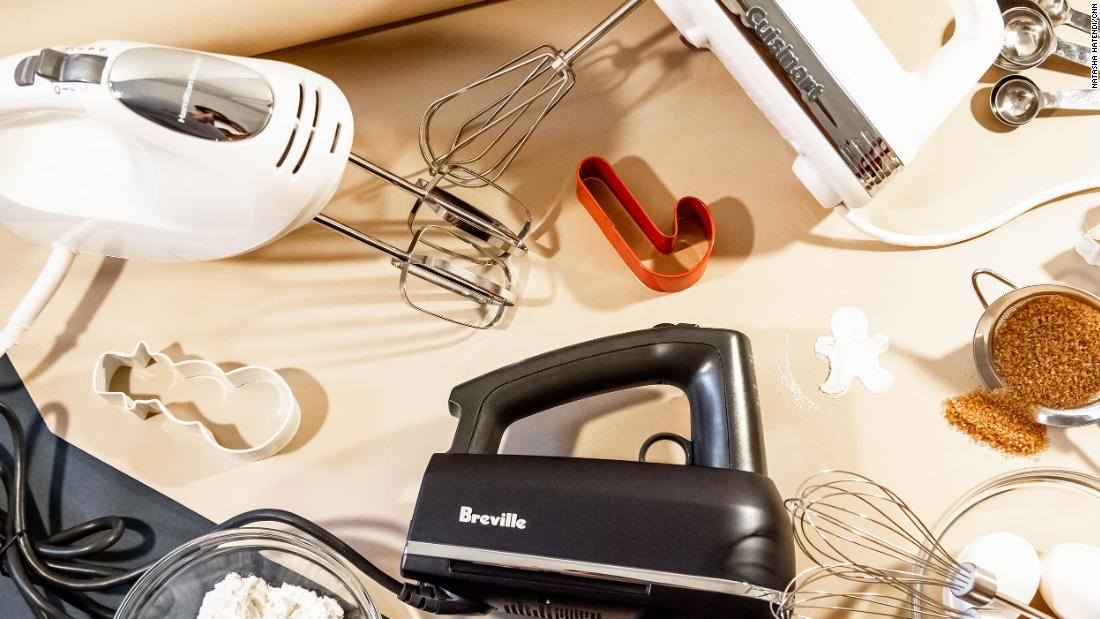
CNN —
Hand mixers are such a low-commitment, space-saving kitchen appliance, which makes buying them a no-brainer. They’re less of an investment in time (setting up, cleaning and putting away) and money than a stand mixer, and the ideal choice when you just want to quickly hammer out some cookie dough, whipped cream or cake mix. In some cases, they can even knead dough or blend soup.
To find the best one, we tested nine top-rated hand mixers over several weeks. We mixed, we beat, we whisked. We made (and ate) 10 sponge cakes while running them through their paces to find the absolute best option for all baking and mixing needs. (Side note: We are never eating sponge cake again.)
Ultimately, three rose to the top:
Best hand mixer overall
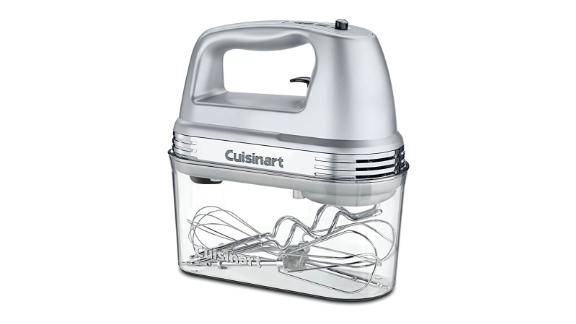
The Cuisinart HM-90BCS Plus mixer caught our eye right out of the box, with a sleek design and sturdy build that felt stable in the hand. Testing confirmed our initial impression, with the appliance scoring top marks across the board for function — easily mixing, whisking, beating and kneading — as well as ease of use and storage.
Best high-end hand mixer

The most expensive of the hand mixers we reviewed, the Breville not only mixed ingredients the fastest out of our testing pool (making quick work of even the heaviest of ingredients), but is also equipped with features that you’d expect for a premium price, including a “headlamp” style light and rubber-coated beaters that make it the quietest of all the mixers we tested.
Best budget hand mixer
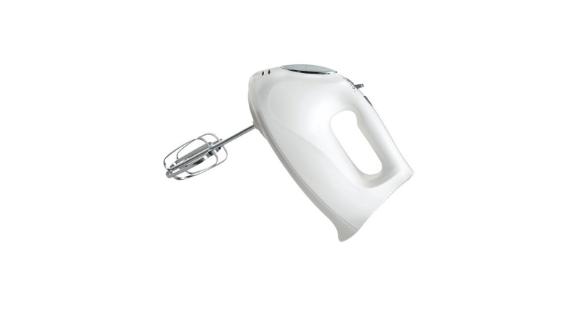
The Hamilton Beach 6-Speed Electric Hand Mixer is a simple, hard-working mixer that gets the job done for less. It’s very easy to maneuver and aptly tackles all of the basic functions — mixing, whisking, beating — though it does lack a kneading attachment and was a bit slower on certain tasks compared to the higher-end hand mixers we tested.

Natasha Hatendi/CNN
We were impressed with this appliance right out of the box. The brushed chrome design is stylish, modern and timeless, and would look great in any kitchen.
The mixer revved right up for the whipped cream test and got us to medium peaks in five minutes and stiff peaks 30 seconds after that. It also created a meringue while whipping egg whites in five minutes flat. All of the mixers delivered whipped cream in a similar timeline (with the noted exception of the Breville, which accomplished the task in three), but what really impressed us about the Cuisinart was how the first three speeds (of nine total) were really gentle and slow. Not once did we find ourselves — or the walls of the kitchen — wearing meringue or whipped cream while whisking them up.
For mixing, we used a simple three-ingredient sponge cake recipe, with eggs, cake flour and granulated sugar, which really tested the mixer’s ability to add air to the eggs, making the cake fluffy and easy to slice. This process requires a good 20 minutes of mixing eggs and slowly adding in sugar to prevent large air holes in the cake. It’s a real test of the baker’s skill and patience, and the most important tool to maintain the required stamina is a lightweight hand mixer that is easy to maneuver. The Cuisinart’s lightness in hand, along with the ease of reach to the up and down speed buttons, made it ideal for a longer task like this. This led to the best cake of the 10 we made during this process, with a fluffy rise that wasn’t dry.
We also tested the mixers for lighter tasks as well: When we gave the Cuisinart a whirl making chocolate chip oatmeal cookies from a mix, the wire beater attachments on the machine handled the heavy ingredients with ease, fully mixing the bowl of oats, chocolate chips, oil and egg in roughly two minutes. The heavier ingredients, just like the light egg whites and cake batter, stayed put in the bowl, which was not the case for several of the other mixers we tested. We also tested the dough hooks for the kneading capability on a simple pizza dough recipe, and the Cuisinart excelled at producing a good rise and creating a nice crispy dough with a chewy crust.
Not only does this machine whip up pro-level baked goods, but it’s also extremely user-friendly. In addition to being lightweight with easy-to-reach buttons, it features an LED display that shows a simple number so you know exactly what level you’re working at, and an eject button, positioned conveniently under the handle, that works with a simple squeeze. The attachments fell out neatly and were easy to clean both by hand and in the dishwasher. Since the Cuisinart didn’t splatter any dough or batter during our testing, we simply wiped off the machine with a damp cloth to clean, no scrubbing required.
The Cuisinart is such a delight to use that we even grabbed it for tasks for which we normally wouldn’t use a mixer, like mashed sweet potatoes. Why hand mash when you can just as easily pull your hand mixer out of the drawer to do the job?
Finally, this quiet little mixer has a storage case that snaps on the bottom, where the attachments and cord can easily be tucked away, making the mixer higher, not wider. Extra storage without a bigger footprint in your kitchen is, quite simply, amazing. If you’ve ever spent 10 minutes angrily fishing around for mixer attachments in the back of your kitchen drawers, you know that this is a fantastic feature.
Between its pro-level whipping abilities and ease-of-use, not to mention its handy storage case, the Cuisinart HM-90BCS 9-Speed Handheld Mixer proved to be the best hand mixer we tested. We’ll be keeping this mixer in heavy rotation whenever we’re in the kitchen.
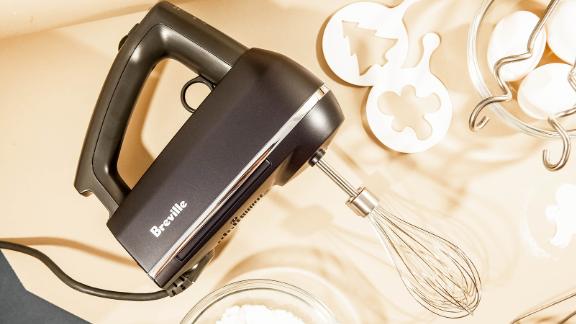
Natasha Hatendi/CNN
The style, versatility, power and speed of the Breville BHM800SIL Hand Mixer make it akin to a sports car of the small-appliance world. For those whose budget allows, that all adds up to a mixer well worth the premium you’d pay in comparison to the Cuisinart.
Not only does the Breville look gorgeous out of the box with clean lines and a modern design, but this mixer is a true powerhouse. We first used it to make whipped cream and meringue with the double whisk attachments, a departure from the single-whisk mixers that made up the bulk of our testing pool. This was a little difficult to manage on the first try, as the two whisks worked with a lot more might and speed than the other mixers’ single whisk. The whipping went surprisingly fast (under three minutes for both whipped cream and meringue), but also sprayed a bit of fluff across the kitchen. After a few tries, we realized it was easier to manage splatter by tipping the bowl sideways.
We started slowly with the sponge cake batter and it mixed the batter with ease, creating a cake with a high rise that was easy to cut without a lot of crumbs. The only issue was the heaviness of the machine. Between the weight and the power, our biceps got a workout holding and steadying it during the extended time it took to mix up the cake.
This mixer scored the maximum points for speed, never slowing down even with heavy ingredients. Beating ability for the oatmeal cookies was powerful and fast, clocking the quickest bowl-to-cookie-sheet time of all the mixers we tested. The ingredients stayed in the bowl and they were mixed evenly. The Breville also has dough hooks, which are sturdy and solidly built and worked the dough with serious power, creating a workable, non-sticky dough that made a perfectly crispy crust pizza.
The Breville didn’t score quite as high for user-friendliness as the Cuisinart, but some of the issues may be a matter of preference. We found the machine a bit heavy and hard to maneuver, and that took a little getting used to. The buttons were easy to use, but as the weight of the mixer pulled on our arm, the tasks grew more tiresome.
The attachments ejected easily — the button is intuitive and worked smoothly — and cleaned up without any difficulty.
For its higher price, the Breville does offer features we didn’t see on any other mixers, like rubber-coated scraper beaters, which (besides being quiet) didn’t have any dough clinging to them when we were done mixing. Multiple reviewers on Amazon, however, noted that the rubber covering came off after heavy use; we didn’t see that during a month of testing, but could understand how in time they potentially could tear. The covering did cut down on clanging and excess noise, though, and overall, the Breville was very quiet, emitting only a gentle, high-pitched whine.
Depending on your passion for eating raw cookie dough off of your beaters (the CDC says don’t do this), the lack of batter on the beaters can be a welcome feature or a drawback. There’s also a mixing light that allows you to see the ingredients during the mixing process, which can be fun for a beginner (or, for secretly mixing at night?), but isn’t something we’d require in a mixer.
Lastly, the Breville comes with snap-on storage and a swivel cord, both of which are extremely handy features. If you’re working in a small or awkward space, the swivel cord really lets you maneuver the mixer in the bowl and get the job done.
If bells and whistles get you excited in the kitchen, and budget isn’t an issue, we highly recommend this Breville. The stylish design, exceptional power, nine speed settings, six attachments and even a headlamp are everything you need in a mixer — and then some — making the Breville BHM800SIL well worth its premium price.
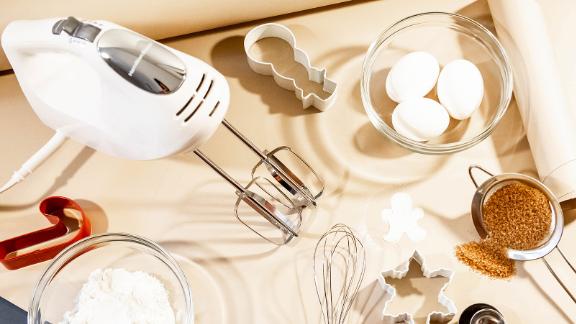
Natasha Hatendi/CNN
We fell in love with this glossy white workhorse, which feels far more expensive and sturdy than its low price suggests.
The Hamilton Beach mixer has six speeds and starts up slowly, which cuts down on mess with more delicate tasks; we saw zero splatter using this tool. But with only a single whisk attachment, it took longer to get egg whites to turn into meringue (five minutes) and heavy cream to whipped cream (five and a half minutes) compared to the pricier models.
The “quick burst” button kicks it into high speed, which helped finish off the meringue really nicely, giving it lots of peaks and that fluffy stiffness bakers look for.
For the sponge cake, we channeled our inner Mary Berry (you can’t make sponge cake without referencing The Great British Baking Show!) and worked the batter into an almost perfect blend. The lightness of the Hamilton Beach, coupled with the bowl rest — grooves on the side so you can balance the mixer on the bowl while mixing, a feature unique to this mixer — made the 20-minute process of feeding sugar into eggs simple and easy. Honestly, we don’t know why all hand mixers don’t have this feature. The final product was a light cake with little crumbing when cut, and very few air holes.
This little machine was also awesome for cookie dough, beating fast and evenly. The ingredients came together quickly, and stayed in the bowl, which is really all we want when mixing up a quick batch of cookies. The standard beaters have a bit of a square shape to them, though, so they did hold on to about half a cookie worth of dough.
Extremely lightweight, this mixer was easy to hold and maneuver, fitting easily into our hand. Getting the attachments ejected took a moment to figure out (you’ve got to give them a good yank), but after that it was a simple process and they were easy to clean. Since we saw minimal splatter with this appliance, clean up was a quick wipe down.
This mixer doesn’t come with dough hooks, so we did not test kneading capabilities. But it was also the only low-priced mixer with snap-on storage for the attachments and cord.
While this mixer lost points for not having dough hooks and taking a little longer than our winners to whip, if you’re looking for a low-priced mixer to tackle most baking tasks and need a lightweight, easy-to-maneuver tool, the Hamilton Beach is a solid choice.
The testing process for these hand mixers was comprehensive, exceptionally delicious and lasted more than a month. We really wanted to put these kitchen essentials to the test and get to the heart of what would be the priorities of someone looking for a hand mixer. We plunged beaters into cookie dough, whisks into heavy cream, beaters (again, after cleaning them!) into cake batter and dough hooks into pizza dough. We took copious notes on which mixers handled the best — both in our hands and in the mix — and how well they were built and stood up to heavy use.
Let’s break down our testing:
Overall function
- Whisking ability: We whisked egg whites and heavy cream, created stiff peaks and fluffy whipped cream, timed each to see how long it took to get the desired results.
- Mixing ability: For this test, we made an absolutely ridiculous amount of sponge cake. More sponge cake than anyone could ever eat — even more than Paul Hollywood — to make sure they mixed batter with ease and created fluffy sponge cake that had few air holes, and cut evenly without lots of crumbs.
- Beating ability: We tested every mixer’s ability to tackle chocolate chip oatmeal cookies, because we wanted to make sure they could handle heavier ingredients.
- Kneading ability: Some of the mixers we tested came with dough hooks or paddles, so we put them through their paces with a simple pizza dough, testing how well they handled the dough and how the pizza turned out.
User friendliness
- How comfortable is it to hold: A mixer can have all the bells and whistles but if you can’t comfortably grip it and use it successfully, it will just sit on a shelf. We rated all mixers on what holding them felt like during use.
- Ease of cleaning: For this we compared how easy it was to clean off any splatter on the machines and the walls, if batter gunking up the works was an issue, and if there were any other complexities to cleaning.
- Ease of use of buttons: Any baker or cook knows that when you’re using a kitchen tool, the key is for it to be easy. Can your fingers or thumb easily click the machine on and off? Is skipping up and down speeds simple or a stretch? Did we test for this? Yes, until our fingers hurt (seriously).
- Ease of attachments: Ever have an attachment go flying off a hand mixer, or struggle to remove one? Us too, so we tested and graded for this.
- Noise levels: Hand mixers aren’t notoriously loud appliances, but we still wanted to know which would keep a more relaxed mood in the kitchen (and not disturb someone’s Zoom call in the next room).
Build
- Quality of materials: We rattled, dropped and shook these little machines to test their strength and ensure they wouldn’t break easily.
- Durability of attachments: We did the same for the attachments, noting which felt hefty and hardworking, and which felt flimsy and not up to the job.
- Ease of storage: Rare is the cook who uses a hand mixer daily, and those attachments have a habit of disappearing, so we took notes on storage options and innovations on all of these machines.
KitchenAid 9-Speed Architect Hand Mixer ($99.99; wayfair.com)
This mixer is appealing to the eye and, with nine speeds, it’s plenty powerful. When we tested the functionality, it nearly came out of our hand when using the dough hooks, but we kept a good grip on the bowl and powered through. The appliance easily whipped up meringue and whipped cream in five minutes, and had no problem powering through the heavy ingredients in the oatmeal cookies. There was a little more of a struggle with the delicate process of mixing the sugar into eggs for the sponge cake, as this machine is very powerful and rattled in our hands when we tried to go slowly.
Where this mixer lost points was in functionality. There’s a small raised silver piece between the up and down speed buttons that looks like it’s just there for design, but it makes it really difficult to switch back and forth between speeds. It’s an unfortunate design choice that led to batter flying everywhere (and some choice words in the process). We cross-checked with Amazon reviews, and many shoppers said the same thing. We also found the whisk a little flimsy. The blender rod for making milkshakes and smoothies is a nice addition, but no substitute for a blender or Nutribullet. It comes with a cloth bag for storing attachments, which is helpful but not as convenient as the built-in storage of our winners.
KitchenAid 7-Speed Digital Hand Mixer ($69.99; amazon.com)
We loved the vintage look of this mid-level mixer, which comes in black, silver, red and white. It also comes with whisk and beater attachments.
Our notes on the functionality of this mixer during testing pretty much boiled down to “It’s okay.” The cake process was fine; the cake came out about average. A little crumby, but not bad. Whipped cream and meringue came together easily in about five minutes with no mess, but the tool struggled with the heavier ingredients in our cookie mix.
And, as we mentioned above with the 9-speed, the mixer lost points due to a small raised silver piece between the up and down speed buttons. This mixer also came with no storage, which was surprising given its price.
KitchenAid Ultra Power 5-Speed Hand Mixer ($54.99; target.com)
Out of all the KitchenAid mixers we tested, this scored the highest points in our tests (though still significantly lower than our picks above) — and was the cheapest — showing that sometimes simpler is indeed better. It comes in a variety of colors like red and purple, so you can coordinate with your kitchen, and has a cute vintage look.
It whisked up meringue and whipped cream in just over five minutes. Switching between speeds was easy and didn’t create a mess. The mixer also tackled sponge cake batter with ease and was light enough that it didn’t feel like a total chore. The sponge cake was dense but light, and if we were able to actually eat cake at that point in testing, we’re sure it was perfect. It handled the heavier ingredients of the cookie mix without making a mess, but was noticeably slower than our best overall pick. It also didn’t feature kneading attachments, which lost it points.
While this mixer was lightweight, it did feel a little awkward at times, it was somewhat difficult to scrape dough from the bottom of the bowl. Unlike the pricier models, though, this mixer had a simple flip up or down button for speed that worked smoothly. The attachments ejected a little wonkily — we pressed the button several times before they popped off — but they cleaned up easily.
Black + Decker Lightweight Hand Mixer ($19.28; amazon.com)
With a classic look, five speeds and a lightweight feel, the Black + Decker is a basic mixer.
In use, it seemed a little lower on power than some of the pricier mixers we tested, and took six minutes to make whipped cream and meringue. For our sponge cake, we used the power boost to help make the batter fluffy, and the cake came out well, baking high. The cookie mix was kind of a disaster with the heavy ingredients gumming up the works and splattering mix on our clothes and face (seriously!).
We also struggled to clean the beater attachments. They really held onto whatever product we used them to mix. Obviously with the splatter, the mixer was covered as well, but it was easily wiped down with soap and water. The build overall was fine — it felt well put together and didn’t rattle, but it was the noisiest mixer we tested.
Dash Smart Store Compact Hand Mixer ($19.99; amazon.com)
This lightweight hand mixer comes out of the box looking simple and stylish, with the mixer attachments lying flush against the body of the mixer. It’s very slim, which made it easy to hold, and it would fit comfortably in many kitchen drawers.
As the Dash Mixer only comes with standard beater attachments, we used those to whisk egg whites and whipped cream, and both took just over five minutes and didn’t make any splatter. The cookie dough and cake batter didn’t go as well. The machine lacked the power to mix the heavy ingredients in the dough, and when we plunged the mixer into the ingredients, the dry mix poofed out of the bowl a bit, leaving cookie-mix dust all over the counter. The sponge cake mixing was pretty tedious as it’s hard to set the mixer down while using it due to the cord position. It was difficult to get the batter just right — the sugar just didn’t blend in the way it was supposed to and our cake was dry and a little sad.
As far as build, the Dash Mixer had a cheap-feeling rattle when we turned the speed up high, and the attachments felt flimsy and fell off when we dropped the machine.
Read more from CNN Underscored’s hands-on testing:
Source: http://rss.cnn.com/~r/rss/cnn_topstories/~3/T_6GXhY4JYQ/index.html


















